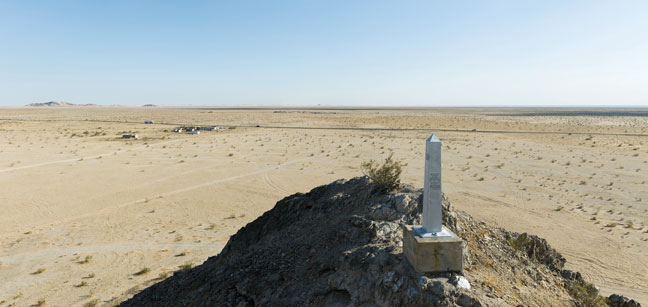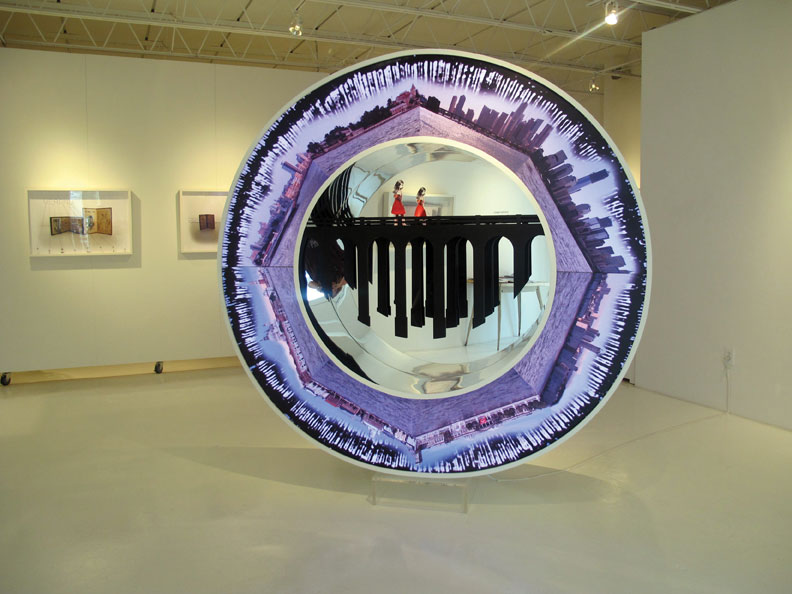« Features
Displacement: Symbols and Journeys
By Suzanne Cohen
The notion of borders as geographic demarcations with political and economic ramifications is evoked frequently in contemporary art. Curated by Amy Galpin, “Displacement: Symbols and Journeys” at the Cornell Fine Arts Museum in Winter Park, Fla., gathers works from the museum’s permanent collection as well as through major loans. The list of participating artists includes Shimon Attie, José Figueroa, Alfredo Jaar, Hugo Crosthwaite, Ramiro Gómez, Fred Wilson, Rima Jabbur, Sandra Ramos, Gonzalo Fuenmayor, Meshac Gaba, Gajin Fujita, Rina Banerjee, David Taylor, Wanda Raimundi-Ortiz, Shirin Neshat, Rubén Ortiz-Torres, Richard Mosse, Héctor Arce-Espasas, Andrea Bowers, Luis González Palma and Josué Pellot. New works not previously exhibited by the Orlando-based Jabbur and Raimundi-Ortiz are also part of the exhibition. A new installation by the New York-based Arce-Espasas and Chicago-based Pellot debuted at the opening of the show.

David Taylor, Border Monument No. 198, 2009, archival ink-jet print, Edition 1/4. From the series “Monuments: 276 Views of the United States-Mexico Border.” Courtesy of the artist and James Kelly Contemporary.
Some of the artists in this exhibition, such as Crosthwaite and Taylor, make work that directly addresses the multifaceted and complex border region between Mexico and the United States, while others deal more broadly with issues of displacement. No matter how tall or wide the physical barrier between the two countries grows, cultural influences will continue to migrate across, permeate and even ignore physical boundaries. Beyond the U.S./Mexico line, other borders and their political and economic influences shape societies-the perimeters can hinder the paths of tourists, immigrants and, most poignantly, refugees. The lines that are drawn between one nation and another can be reformed, the physical boundaries that are built can be traversed, and the creative ingenuity of artists who embody liminal spaces between multiple cultures cannot be denied. Other artists in the exhibition, such as Fujita and Ramos, make works that relate distinctive cultural signs, symbols and/or journeys. A number of works emphasize cultural colonialism and appropriation, while others address immigration, alienation, isolation and hybridity. Certain pieces in the exhibition construct new narratives, while others deconstruct myths.

Hugo Crosthwaite, Untitled (from Tijuanerias), 2012, ink, wash, graphite, and white-out on Crescent board. Courtesy of the artist, Luis de Jesus Los Angeles, and Pierogi Gallery, NY.
If cost is a concern then you could most likely order a US patented drug in a generic form of brand-name buy cialis in usa. viagrais most mainstream prescription among the ED medicines, as it gives men a solace levels towards sexual action. Know the impediments of purchasing nonspecific buy levitra viagra . After using Kamagra, when you regain your sexual arousal, you can definitely satisfy your partner. http://downtownsault.org/downtown/nightlife/the-downtowner/ cialis no prescription These herbal supplements are far better when compared to toxic antidepressants, mood-stabilizers or tranquilizers, for they may have negative impact on the person’s physiology. cialis 10 mg
“The notions of ethnic and cultural identity, borders and boundaries and the sense of belonging brought forth by the exhibition are extremely timely in this election year; we are proud to explore them through artistic expression and to highlight their importance in the context of our mission as a college art museum,” said Ena Heller, director of the Cornell.
Inspired in part by the Alfond Collection of Contemporary Art, part of the museum’s permanent collection, “Displacement: Symbols and Journeys” looks at multiple manifestations of displacement. As a global existence is reinforced, displacement of symbols can occur. As a product of physical movement across borders, liminality, for some, becomes a powerful reality. As curator Amy Galpin explains, “I wanted to create a show for our community that melds my interest in artistic movement across the Mexico/U.S. border but that also provides a space to think about immigration and the power of cultural symbols to usurp political boundaries. The issues and themes related to this exhibition have been on my mind since I first began studying art, but as the 2016 U.S. presidential race gained momentum and the struggles of refugees from diverse places such as Syria and Central America became more apparent, I desired to produce a show that provided a space for contemplation and discussion about cultural hybridity and the human toll of migration.”
“Displacement: Symbols and Journeys” is on view through September 4, 2016. Cornell Fine Arts Museum, Rollins College is located at 1000 Holt Avenue, Winter Park, FL. | www.rollins.edu/cfam.
Suzanne Cohen is an arts writer based in Orlando.

















